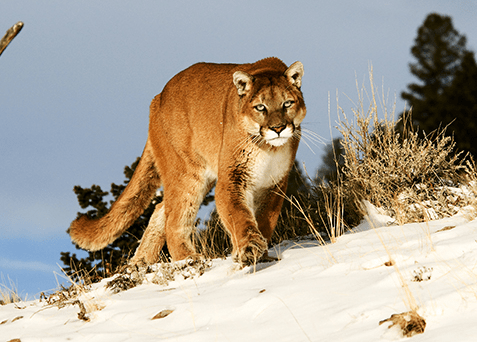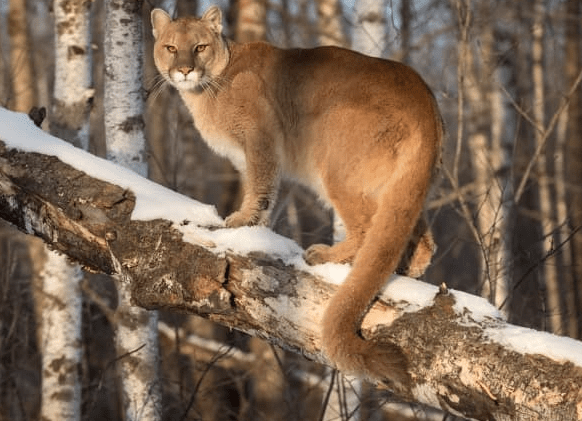Cougars in Ontario and Wildlife Conservation
Cougars, also known as mountain lions, are large predatory cats that once roamed freely throughout North America, including Ontario. This article will provide an overview of the history and importance of studying cougars in Ontario, as well as an overview of Ontario’s diverse wildlife.
Ontario Wildlife

Ontario is home to a wide variety of wildlife, including mammals, birds, reptiles, and amphibians. Some of the species found in Ontario include black bears, white-tailed deer, moose, wolves, beavers, and bald eagles. The conservation of wildlife in Ontario is important due to their ecological, economic, and cultural significance.
Conservation of Wildlife in Ontario
Ontario has a number of conservation initiatives in place to protect its wildlife, such as the Endangered Species Act and the Species at Risk program. These initiatives aim to protect species and their habitats, as well as to prevent and manage threats to wildlife.
Threats to Wildlife in Ontario
Despite conservation efforts, there are still threats to wildlife in Ontario, such as habitat loss, pollution, and climate change. These threats can have a negative impact on the health and survival of wildlife populations.
Ontario Puma Foundation
The Ontario Puma Foundation is a non-profit organization that is dedicated to the conservation of cougars in Ontario.
Mission of the Ontario Puma Foundation
The mission of the Ontario Puma Foundation is to promote the conservation of cougars and their habitats in Ontario through education, research, and advocacy.
Programs and Initiatives of the Ontario Puma Foundation
The Ontario Puma Foundation has a number of programs and initiatives in place to achieve their mission, such as research projects, public education programs, and outreach initiatives.
Research on Cougars in Ontario
The Ontario Puma Foundation conducts research on cougars in Ontario to better understand their habitat, behavior, and population dynamics. This research is used to inform conservation initiatives and management strategies.
Cougars in Ontario
The cougar, also known as the eastern cougar or puma, is the largest cat species in North America and is currently listed as “endangered” on the Species at Risk in Ontario List. However, the provincial government has been hesitant to confirm the existence of wild cougars in Ontario, despite over 2,000 reported sightings since 2002.
Habitat and Distribution of Cougars in Ontario
Cougars in Ontario are primarily found in the northern and western regions of the province, where their habitat includes forests, swamps, and rocky areas. It is important to protect and conserve the habitat of cougars in Ontario to ensure their survival and to maintain the health of the ecosystem.
Behaviour and Diet of Cougars in Ontario
Cougars are solitary and territorial animals that prey on a variety of animals, including deer, elk, and small mammals. While cougars generally avoid interactions with humans, they can be dangerous if they feel threatened or cornered. It is important to be aware of their presence and take precautions when in their habitat.
Interaction of Cougars with Humans and Other Wildlife in Ontario
Cougars in Ontario play an important role in the ecosystem as top predators. The Ontario Ministry of Natural Resources (MNR) regulates hunting and monitors the population of cougars in Ontario to ensure their sustainability.
Management of Cougars in Ontario

The management of cougars in Ontario is the responsibility of the Ontario MNR. The MNR regulates hunting and monitors populations to ensure their sustainability. The Ontario Puma Foundation conducts research on cougars to better understand their habitat, behavior, and population dynamics. This research is used to inform conservation initiatives and management strategies.
In 2010, two individuals submitted an application alleging that commercial forestry operations in the Nighthawk Forest near Timmins contravened the Endangered Species Act by destroying cougar habitat. While the MNR denied the application for investigation, concerns have been raised about how the ministry interprets its responsibilities towards species at risk and the narrow definition of “habitat” under the ESA. The wider implications of the ministry’s approach to habitat protection apply to other species as well, and the Environmental Commissioner of Ontario (ECO) urges the MNR to ensure that habitat quality is taken into account in its definition of habitat damage or destruction.
Ontario Ministry of Natural Resources (MNR)
The Ontario Ministry of Natural Resources (MNR) is responsible for the management and conservation of wildlife in Ontario.
Role of the Ontario MNR in the Management of Cougars in Ontario
The Ontario MNR regulates hunting and monitors the population of cougars in Ontario to ensure their sustainability.
Regulations Related to Cougars in Ontario
The hunting of cougars in Ontario is regulated by the Ontario Ministry of Natural Resources (MNR) under the Fish and Wildlife Conservation Act. It is illegal to hunt cougars without a valid license, and there are strict regulations on the hunting season, bag limits, and methods of take.
In addition to hunting regulations, the MNR also monitors the population of cougars in Ontario and works to ensure their sustainability. This includes conducting research on population dynamics and habitat requirements, as well as implementing conservation initiatives to protect and enhance their habitat.
It is important for individuals to follow hunting regulations and report any sightings of cougars to the MNR or the Ontario Puma Foundation to aid in their conservation efforts. By working together, we can help ensure the survival of cougars in Ontario and protect the rich diversity of wildlife that calls the province home.
Eastern Cougar
The eastern cougar is a subspecies of the cougar that was once found throughout eastern North America, including Ontario.
Status of the Eastern Cougar in Ontario
The eastern cougar was officially declared extinct in 2011 by the Committee on the Status of Endangered Wildlife in Canada (COSEWIC). However, there have been reported sightings of cougars in Ontario, which may indicate the presence of the eastern cougar or other subspecies.
Research on the Eastern Cougar in Ontario
The Ontario Puma Foundation and other organizations conduct research on the eastern cougar to better understand its population status and habitat requirements.
Unique Features of Cougars
Cougars are known for their powerful hind legs, which allow them to jump up to 20 feet horizontally and 15 feet vertically. They are also known for their keen eyesight and hearing, as well as their ability to purr like domestic cats.
One notable cougar in Ontario is the “Haliburton cougar,” which was sighted and photographed in 2012. This cougar gained widespread media attention and sparked debates about the presence of cougars in Ontario.
Cougars have played an important role in the mythology and culture of many indigenous peoples in North America. They are often associated with power, strength, and protection.
Protecting Cougars and Ontario’s Wildlife
Cougars are an important part of Ontario’s wildlife and ecosystem. Studying and conserving these animals is important for their survival and for the health of the ecosystem as a whole. Future research directions should focus on understanding the population status and habitat requirements of cougars in Ontario, as well as the ecological impact of their presence. The conservation of wildlife in Ontario is a shared responsibility that requires cooperation between government agencies, non-profit organizations, and the public.
In Ontario, the protection of cougars and other wildlife is of utmost importance, and we must take action to preserve their natural habitats and ensure their survival for future generations. One way to achieve this is through tax incentives and easements for conservation efforts.
If you are interested in learning more about how tax incentives and easements can help protect the environment and wildlife in Ontario, we invite you to visit our page on Protecting the Environment with Tax Incentives & Easements. There, you can find valuable information on how these programs work and how they can be utilized to support wildlife conservation efforts.
FAQs
What is the difference between a cougar and a mountain lion?
“Cougar” and “mountain lion” are different names for the same species of cat, Puma concolor.
Are cougars dangerous to humans?
While cougars generally avoid interactions with humans, they can be dangerous if they feel threatened or cornered. It is important to be aware of their presence and take precautions when in their habitat.
How can I report a cougar sighting in Ontario?
Sightings of cougars in Ontario should be reported to the Ontario Ministry of Natural Resources (MNR) or the Ontario Puma Foundation.
What should I do if I encounter a cougar in Ontario?
If you encounter a cougar in Ontario, it is important to remain calm and avoid running away. Make yourself appear as large as possible, make noise, and slowly back away while keeping your eyes on the animal.